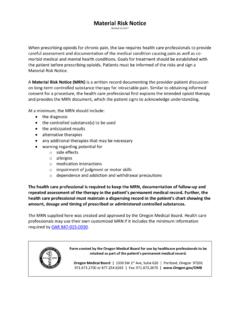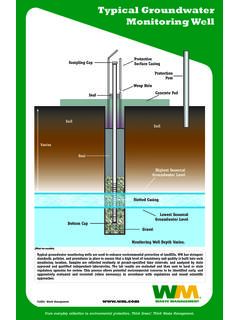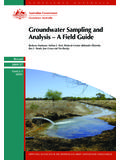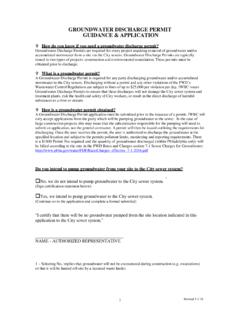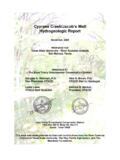Transcription of 333-061-0036 Sampling and Analytical Requirements
1 OAR 333-061-0036 (1) Page 1 of 102 Effective January 10, 2018 333-061-0036 Sampling and Analytical Requirements (1) General: (a) Samples required by these rules must be analyzed using EPA approved methods set forth in 40 CFR 141 by a laboratory accredited according to OAR chapter 333, division 064 and the Oregon Environmental Laboratory Accreditation Program (ORELAP). The laboratory must be certified to analyze drinking water samples using the specific method for the contaminant being analyzed. (A) The Authority will only accept sample results that have been handled and documented according to ORELAP standards, except as prescribed by subsection (1)(i) of this rule. (B) Samples required by these rules must be collected after the water has been allowed to flow from the sample tap for a sufficient length of time to assure that the collected sample is representative of water in the distribution system or from the water source as applicable, except samples for lead or copper in tap water which must be collected as prescribed by subsection (10)(b) of this rule.
2 (b) Accredited laboratories are considered either a primary or subcontracted laboratory as specified by paragraphs (1)(b)(A) and (B) of this rule. (A) A primary laboratory is the first accredited laboratory that receives a compliance sample for analysis, and is responsible for chain of custody documentation (if applicable), performing the Analytical method on a compliance sample (if applicable), final report review, and submission of results to the water system and the Authority as specified in OAR 333-061-0040(1)(b)(B). Primary laboratories must hold primary or secondary ORELAP accreditation. (B) A subcontracted laboratory is an accredited laboratory that performs the Analytical method on a compliance sample, and is responsible for sample analysis and result reporting to the primary laboratory as specified in OAR 333-061-0040(1)(b)(B). Subcontracted laboratories must hold ORELAP primary or secondary accreditation for the appropriate method(s).
3 (c) Alternate Analytical Methods: (A) With the written permission of the Authority, and concurred in by the Administrator of the EPA, an alternate Analytical method may be employed on the condition that it is substantially equivalent to the prescribed test in both precision and accuracy as it relates to the determination of compliance with any MCL; and (B) The use of the alternate Analytical method shall not decrease the frequency of Sampling required by these rules. (d) Monitoring at purchasing water systems: OAR 333-061-0036 (1) Page 2 of 102 Effective January 10, 2018 (A) When a public water system obtains its water, in whole or in part, from one or more public water systems, the monitoring Requirements imposed by these rules on the purchasing water system may be modified by the Authority to the extent that the system supplying the water is in compliance with its source monitoring Requirements . When a public water system supplies water to one or more other public water systems, the Authority may modify monitoring Requirements imposed by this rule to the extent that the interconnection of the systems justifies treating them as a single system for monitoring purposes.
4 (B) Any modified monitoring shall be conducted pursuant to a schedule specified by the Authority and concurred in by the Administrator of the US Environmental Protection Agency. (e) Water suppliers shall monitor each water source individually for contaminants listed in OAR 333-061-0030, except for coliform bacteria, HAA5s, TTHMs and corrosion by-products, at the entry point to the distribution system except as described below. Any such modified monitoring shall be conducted pursuant to a schedule prescribed by the Authority. (A) At water systems drawing water from more than one source and where sources are combined before distribution, water suppliers may be allowed to sample at an entry point to the distribution system during normal operating conditions, where justified, taking into account operational considerations, geologic and hydrologic conditions, and other factors. (B) If a water system draws water from multiple ground water sources which are not combined before distribution, the water supplier may be allowed to sample at a representative source or sources, where justified, taking into account geologic and hydrogeologic conditions, land uses, well construction, and other factors.
5 (f) Compliance with MCLs shall be based on each Sampling point as described in this section. If any point is determined to be out of compliance, the system shall be deemed out of compliance. If an entirely separated portion of a water system is out of compliance, then only that portion of the system shall be deemed out of compliance. (g) The Authority may require additional Sampling and analysis for the contaminants included in OAR 333-061-0030 when necessary to determine whether an unreasonable risk to health exists. The Authority may also require Sampling and analysis for additional contaminants not included in OAR 333-061-0030 when necessary for public health protection. (h) Water suppliers and their appointed representatives shall collect water samples from representative locations in the water system as prescribed in this rule and shall employ proper Sampling procedures and techniques. Samples submitted to laboratories for analysis shall be clearly identified and shall include the name of OAR 333-061-0036 (1) Page 3 of 102 Effective January 10, 2018 the water system, public water system identification number, Sampling date, and time, sample location identifying the sample tap and the name of the person collecting the sample.
6 (i) Measurements for turbidity, disinfectant residual, temperature, alkalinity, calcium, conductivity, chlorite, bromide, TOC, SUVA, dissolved organic carbon, UV254, orthophosphate, silica and pH may be performed on site using approved methods by individuals trained in Sampling and testing techniques. Daily chlorite samples measured at the entrance to the distribution system must be performed by a party approved by the Authority. (j) Nothing in these rules precludes the Authority or any of its duly authorized representatives from collecting samples and from using the results of such samples to determine compliance with applicable Requirements of these rules. (k) Wellfield Determination. (A) At water systems possessing two or more wells that separately supply water to the distribution system, the Authority may consider those wells as a wellfield source for monitoring purposes provided the Requirements of this rule are met. The Authority will determine whether the wellfield designation is appropriate based on information in a water system's source water assessment report.
7 (B) To be classified as a wellfield, wells must meet the following criteria: (i) The wells must be within 2,500 feet of one another or as determined in a state approved hydrogeological study to minimize inter-well interference drawdowns. For wells located in a low-impact land use area, this criterion may be waived at the discretion of the Authority. (ii) The wells must produce water from the same aquifer. This criterion is determined using source water assessment results, based on well reports, maps and other hydrogeological information. (C) To be considered for wellfield designation, water suppliers must submit the following to the Authority: (i) A schematic drawing showing all sources, entry points and relevant sample taps; (ii) A map and description of the land use activities within the respective WHPAs (using the inventory section of the Source Water Assessment Report); and (iii) A description of the pumping patterns. (D) If a water system's wells are considered to comprise a wellfield, the susceptibility analysis conducted during the source water assessment is utilized to determine the Sampling point(s).
8 Table 14 summarizes the alternatives: OAR 333-061-0036 (1) Page 4 of 102 Effective January 10, 2018 Table 14 A B C Designation Sample Location Y Y Y EP for wellfield Most susceptible well Entry point Y Y N Wellfield Entry point for most susceptible well N Y Y EP for wellfield Entry point for wellfield Y N Y EP for wells (not a wellfield) Entry point N N Y EP for wells (not a wellfield) Entry point Y N N Separate (not a wellfield) Each entry point separately N Y N Separate (not a wellfield) Each entry point separately N N N Separate (not a wellfield) Each entry point separately Note: A: wells are within 2,500 feet of each other; B: wells are in the same and no other aquifer; C: wells have a common entry point to the distribution system and pump simultaneously. (E) To determine the most susceptible well, the area within the two-year TOT is considered. The Authority will consider the potential contaminant source inventory determined during the source water assessment, the aquifer sensitivity as defined in OAR 333-061-0050, pumping patterns and other pertinent hydrogeological information.
9 (F) The Authority may still designate more than one entry point within the wellfield as a Sampling point if well construction or land use practices warrant. For a large area containing numerous wells, sub-wellfields may be identified, each with its own sample site designation.(2) Inorganic chemicals. (a) Antimony, Arsenic, Barium, Beryllium, Cadmium, Chromium, Cyanide, Fluoride, Mercury, Nickel, Selenium and Thallium. (A) Sampling at water systems for regulated inorganic chemicals shall be conducted as follows: (i) At community and NTNC water systems using surface water or GWUDI sources solely or in combination with groundwater sources, water suppliers must monitor at each point in the distribution system representative of each source after treatment or at entry points to the distribution system after any application of treatment. Initial monitoring must be conducted annually at each OAR 333-061-0036 (2) Page 5 of 102 Effective January 10, 2018 Sampling point.
10 Samples must be collected at the same Sampling point unless conditions make another Sampling point more representative of each source or treatment plant. (ii) At community and NTNC water systems using groundwater sources, water suppliers must monitor at each point in the distribution system representative of each source after treatment or at entry points to the distribution system representative of each source after any application of treatment. Monitoring must be conducted once every three years at each Sampling point. Samples must be collected at the same Sampling point unless conditions make another Sampling point more representative of each source or treatment plant. (iii) At new TNC and state regulated water systems or existing TNC and state regulated water systems with new sources, water suppliers must monitor once for arsenic. Samples must be collected at the entry points to the distribution system representative of each source after any application of treatment.








